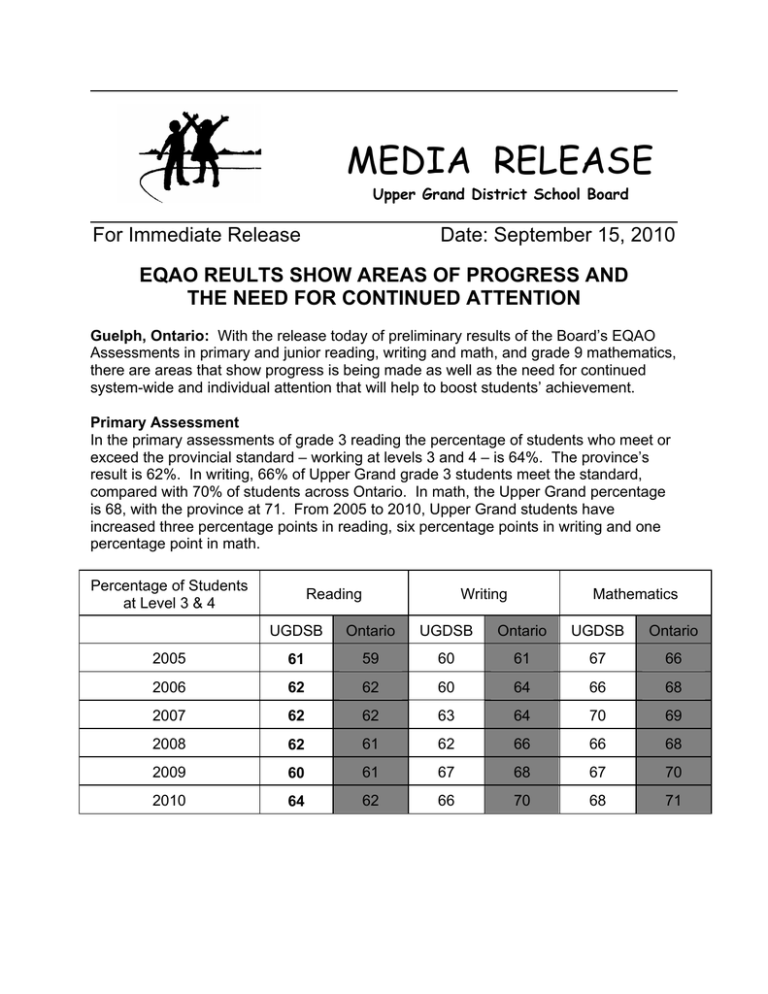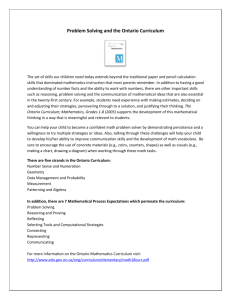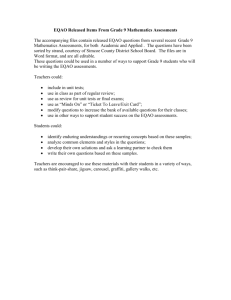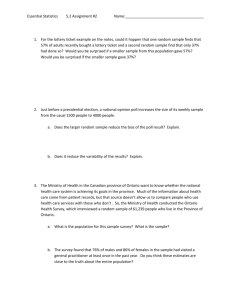MEDIA RELEASE EQAO REULTS SHOW AREAS OF PROGRESS AND
advertisement

MEDIA RELEASE Upper Grand District School Board For Immediate Release Date: September 15, 2010 EQAO REULTS SHOW AREAS OF PROGRESS AND THE NEED FOR CONTINUED ATTENTION Guelph, Ontario: With the release today of preliminary results of the Board’s EQAO Assessments in primary and junior reading, writing and math, and grade 9 mathematics, there are areas that show progress is being made as well as the need for continued system-wide and individual attention that will help to boost students’ achievement. Primary Assessment In the primary assessments of grade 3 reading the percentage of students who meet or exceed the provincial standard – working at levels 3 and 4 – is 64%. The province’s result is 62%. In writing, 66% of Upper Grand grade 3 students meet the standard, compared with 70% of students across Ontario. In math, the Upper Grand percentage is 68, with the province at 71. From 2005 to 2010, Upper Grand students have increased three percentage points in reading, six percentage points in writing and one percentage point in math. Percentage of Students at Level 3 & 4 Reading Writing Mathematics UGDSB Ontario UGDSB Ontario UGDSB Ontario 2005 61 59 60 61 67 66 2006 62 62 60 64 66 68 2007 62 62 63 64 70 69 2008 62 61 62 66 66 68 2009 60 61 67 68 67 70 2010 64 62 66 70 68 71 Primary EQAO 2005- 2010 Results Comparison 2005 2006 2007 2008 2009 2010 100 90 80 70 60 61 62 62 62 60 64 63 62 60 60 67 66 67 66 70 68 66 67 50 40 30 20 10 0 Reading Writing Math Both ELL students (English Language Learners) and special needs (not gifted) students lag behind their classmates in all three areas. Except in math, where they are tied, primary girls achieve at a higher level than boys. Junior Assessment Grade 6 students meeting or exceeding the reading standard this year is 74%, with the province reaching 72%. Writing results show the board’s students at 69%, compared with 70% for the province. Math assessments show 59% of students meeting or exceeding the standard compared with the provincial result of 61%. Over the years from 2005 to 2010, the board has improved by eight percentage points in reading, 10 in writing and has dropped three percentage points in math. Percentage of Students at Level 3 & 4 Reading Writing Mathematics UGDSB Ontario UGDSB Ontario UGDSB Ontario 2005 66 63 59 59 62 60 2006 65 64 60 61 62 61 2007 68 64 61 61 59 59 2008 69 66 67 67 60 61 2009 72 69 66 67 61 63 2010 74 72 69 70 59 61 Junior EQAO 2005 - 2010 Results Comparison 2005 2006 2007 2008 2009 2010 100 80 69 66 65 68 72 74 67 65 69 59 60 61 60 62 62 59 60 61 59 40 20 0 Reading Writing Math While Junior girls outperform boys in reading and writing, and math. ELL and special needs students (not gifted) do not perform as well as the others. Grade 9 Mathematics Assessment In Grade 9 math, there are two levels of study, applied and academic. Students in the academic program are consistently above the province with 86% meeting or exceeding the standard, compared with the province at 82% In applied math, the province is at 40% while Upper Grand students are at 47%. The gender gap shows that boys consistently outperform girls in both applied and academic math. In a survey of these students, more girls indicated that they found math “boring” than boys. ELL and special needs students (not including gifted students) scored at 86% and 83% (academic) and at 48% and 38% (applied). Results by Program of Study – Applied Results Over Time – Applied Results by Program of Study – Academic Results Over Time – Academic This is the first year that individual student progress can be tracked. This shows how a child who wrote the primary and junior assessments and the grade 9 math assessment has fared over their school career. These results also can track students between the primary and junior assessments. In all cases, students who met the standards in primary and junior are most likely to maintain that standard in grade 9. Those that struggle early on are more likely to continue to struggle in the higher grades. What this tells educators is that if you can identify struggling students early on support can make a difference. The board now has data that shows how many students rose to the standard, both between grade 3 and 6 in all areas (reading, writing and math) and between grade 6 and 9 in math. Based on the data from the most recent test, the Board has identified a number of strategies that have worked to raise achievement levels and those that will target specific areas as well as students. With a focus on reading skills in past years, achievement rates have climbed. A group of schools will begin to focus on math in the primary and junior grades, as well as writing in some areas. Teacher in-services and resource materials from the province are helpful in this work. At the secondary level, there is ongoing attention to math coaching for teachers in the schools and the use of resource binders and technology to engage students in their learning, which helps improve achievement. Special needs students, those for whom English is not the first language spoken at home and the many students who are just on the edge of moving from level 2 work to level 3 work are ongoing targets for support. Additional information and school by school results are posted on the board’s website. Additional information is also available at the EQAO’s webstie: www.eqao.com. -30- For more information: Maggie McFadzen, Communications Officer, 519-822-4420, ext. 725 Maggie.mcfadzen@ugdsb.on.ca


